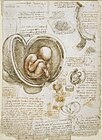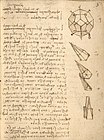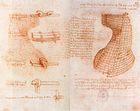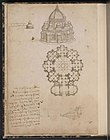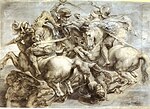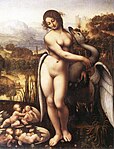List of works by Leonardo da Vinci
 From Wikipedia - Reading time: 30 min
From Wikipedia - Reading time: 30 min
The Italian polymath Leonardo da Vinci (1452–1519) was the founding figure of the High Renaissance, and exhibited enormous influence on subsequent artists. Only around eight major works—The Adoration of the Magi, Saint Jerome in the Wilderness, the Louvre Virgin of the Rocks, The Last Supper, the ceiling of the Sala delle Asse, The Virgin and Child with Saint Anne and Saint John the Baptist, The Virgin and Child with Saint Anne, and the Mona Lisa—are universally attributed to him, and have aroused little or no controversy in the past. Ten additional works are now widely attributed to his oeuvre, though most have previously incited considerable controversy or doubt: the Annunciation, Madonna of the Carnation, The Baptism of Christ (with his teacher, Verrocchio), Ginevra de' Benci, the Benois Madonna, the Portrait of a Musician (with possible studio assistance), the Lady with an Ermine, La Belle Ferronnière, the London Virgin of the Rocks (with studio assistance), the Portrait of Isabella d'Este, and Saint John the Baptist.
Other attributions are more complicated. La Scapigliata appears to be attributed by most scholars, but some prominent specialists are silent on the issue. Salvator Mundi's attribution remains extremely controversial, and the extensive nature of the restoration may never allow a definitive resolution. The small number of surviving paintings is due in part to Leonardo's habit of disastrous experimentation with new techniques and his chronic procrastination, resulting in many incomplete works. It is thought that he created many more works that are now lost, though records and copies have survived for some.
In addition to his paintings, there are eleven surviving manuscripts of Leonardo da Vinci's notes and drawings, amounting to thousands of pages in total. There are numerous other works with disputed attributions to Leonardo, which have failed, as of yet, to achieve thorough scholarly approval.
Major extant works
[edit]Key: † Collaborative work · ‡ Possibly collaborative work
| Universally accepted | Unanimously accepted works |
|---|---|
| Widely accepted | Accepted by large majority of modern scholars; controversial in the past |
| Generally accepted | Accepted by most modern scholars; still controversial |
| Title and image | Date | Medium | Dimensions[1] | Location[1] |
|---|---|---|---|---|
| c. 1472–1476[d 1] | Oil and tempera on poplar panel | 98 cm × 217 cm 39 in × 85 in |
Uffizi, Florence | |

|
||||
| Madonna of the Carnation | c. 1472–1478[d 2] | Oil on poplar panel | 62 cm × 47.5 cm 24.4 in × 18.7 in |
Alte Pinakothek, Munich |

|
| |||
| c. 1474–1478[d 3] | Oil and tempera on poplar panel | 177 cm × 151 cm 70 in × 59 in |
Uffizi, Florence | |
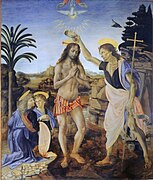
|
| |||
| Ginevra de' Benci | c. 1474–1480[d 4] | Oil and tempera on poplar panel | 38.8 cm × 36.7 cm 15.3 in × 14.4 in |
National Gallery of Art, Washington, D.C. |

|
| |||
| Benois Madonna | c. 1478–1481[d 5] | Oil on wood panel, transferred to canvas | 49.5 cm × 33 cm 19.5 in × 13.0 in |
Hermitage, Saint Petersburg |
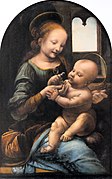
|
| |||
|
The Adoration of the Magi |
c. 1478–1482[d 6] | Oil (underpainting) on wood panel | 240 cm × 250 cm 94 in × 98 in |
Uffizi, Florence |
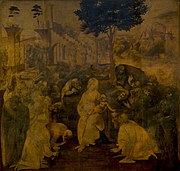
|
| |||
| Saint Jerome in the Wilderness (unfinished) |
c. 1480–1490[d 7] | Tempera and oil on walnut panel | 103 cm × 75 cm 41 in × 30 in |
Vatican Museums |

|
| |||
| Madonna Litta † | c. 1481–1495[d 8] | Tempera (and oil) on poplar panel | 42 cm × 33 cm 17 in × 13 in |
Hermitage, Saint Petersburg |

|
| |||
| Virgin of the Rocks (Louvre version) |
c. 1483–1493[d 9] | Oil on wood panel, transferred to canvas | 199 cm × 122 cm 78 in × 48 in |
Louvre, Paris |

|
| |||
| Portrait of a Musician (unfinished) ‡ |
c. 1483–1487[d 10] | Oil (and tempera?) on walnut panel | 45 cm × 32 cm 18 in × 13 in |
Pinacoteca Ambrosiana, Milan |

|
| |||
| Lady with an Ermine | c. 1489–1491[d 11] | Oil on walnut panel | 54 cm × 39 cm 21 in × 15 in |
Czartoryski Museum, Kraków |

|
| |||
| La Belle Ferronnière | c. 1490–1498[d 12] | Oil on walnut panel | 62 cm × 44 cm 24 in × 17 in |
Louvre, Paris |

|
| |||
| Virgin of the Rocks (London version) † |
c. 1491–1508[d 13] | Oil on parqueted poplar panel | 189.5 cm × 120 cm 74.6 in × 47.2 in |
National Gallery, London |

|
| |||
| c. 1492–1498[d 14] | Tempera on gesso, pitch and mastic | 460 cm × 880 cm 180 in × 350 in |
Convent of Santa Maria delle Grazie, Milan | |

|
| |||
| Sala delle Asse | c. 1497–1499[d 15] | Tempera on plaster | Castello Sforzesco, Milan | |
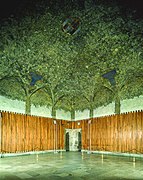
|
| |||
|
The Virgin and Child with Saint Anne and Saint John the Baptist |
c. 1499–1508[d 16] | Charcoal, black and white chalk on tinted paper, mounted on canvas | 142 cm × 105 cm 56 in × 41 in |
National Gallery, London |

|
| |||
| Portrait of Isabella d'Este | c. 1499–1500[d 17] | Black and red chalk, yellow pastel chalk on paper | 61 cm × 46.5 cm 24.0 in × 18.3 in |
Louvre, Paris |
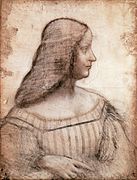
|
| |||
| Madonna of the Yarnwinder (The Buccleuch Madonna) † |
c. 1499–1508[d 18] | Oil on walnut panel | 48.9 cm × 36.8 cm 19.3 in × 14.5 in |
Scottish National Gallery, Edinburgh[b] |

|
| |||
| Salvator Mundi ‡ | c. 1499–1510[d 19] | Oil on wood panel | 65.6 cm × 45.4 cm 25.8 in × 17.9 in |
Unknown |

|
| |||
| Madonna of the Yarnwinder (The Lansdowne Madonna) † |
c. 1501–1508[d 20] | Oil on wood panel (transferred to canvas and later re-laid on panel) | 50.2 cm × 36.4 cm 19.8 in × 14.3 in |
Private collection, New York City |

|
| |||
| c. 1501–1519[d 21] | Oil on wood panel | 168 cm × 112 cm 66 in × 44 in |
Louvre, Paris | |

|
| |||
| Mona Lisa (unfinished) |
c. 1502–1516[d 22] | Oil on cottonwood (poplar) panel | 76.8 cm × 53 cm 30.2 in × 20.9 in |
Louvre, Paris |
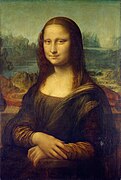
|
| |||
| La Scapigliata (unfinished) |
c. 1506–1508[d 23] | Earth, amber and white lead on wood panel | 24.7 cm × 21 cm 9.7 in × 8.3 in |
Galleria Nazionale, Parma |

|
||||
| Saint John the Baptist | c. 1507–1516[d 24] | Oil on walnut panel | 69 cm × 57 cm 27 in × 22 in |
Louvre, Paris |

|
| |||
Manuscripts
[edit]| Title and sample image | Dates | Abbreviation(s)[38] | Pages | Location |
|---|---|---|---|---|
| Codex Atlanticus | 1478–1519 | C.A. | 1,119 | Pinacoteca Ambrosiana, Milan |
|
|
| |||
| Codex Windsor | 1478–1518 | W. | 153 | Royal Collection, Windsor |
|
|
| |||
| Codex Arundel | 1480–1518 | B.L., Arundel MS. or Br.M. | 283 | British Library, London |
| Codex Trivulzianus | c. 1487–1490 | Triv. | 55 (originally 62) |
Biblioteca Trivulziana, Castello Sforzesco, Milan |
| Codex Forster | 1487–1505 | Forster I, II and III (including I1, I2 and II2); formerly known as S.K.M.I, II and III | 354 | Victoria and Albert Museum, London |
|
|
| |||
| Paris Manuscripts | 1488–1505 | A, B, C, D, E, F, G, H (including H1, H2 and H3), I (including I1 and I2), K (including K1, K2 and K3), L and M | more than 2,500 | Bibliothèque de l'Institut de France, Paris |
|
|
| |||
| Codex Madrid | 1490s–1504 | Madrid I and Madrid II | Biblioteca Nacional de España, Madrid | |
|
|
| |||
| Codex Ashburnham | c. 1492 | Ash.I. or B.N.2037 (formerly part of MS.B.); Ash.II or B.N.2038 (formerly part of MS.A.) | Bibliothèque de l'Institut de France, Paris | |
| ||||
| Codex on the Flight of Birds | dated 1505 | Turin | 18 | Biblioteca Reale, Turin |
|
|
| |||
| Codex Leicester | 1506–1510 | Leic. | 72 | Collection of Bill Gates, Seattle (tours internationally) |
| Codex Urbinas and libro A | c. 1530 | Urb. and L°A. | Biblioteca Apostolica Vaticana | |
| ||||
Lost works
[edit]| Title, and image of derivative work[57] |
Date[57] | Type[57] | Last known location[57] |
|---|---|---|---|
| Adam and Eve (unfinished) |
c. mid 1460s – early 1470s | Watercolor cartoon for a tapestry | In the collection of Ottaviano de' Medici during Vasari's lifetime (1511–1574) |
|
|
| ||
| Dragon shield | c. 1472 | Painted shield | Unknown |
| |||
| The Head of Medusa | Youthful work | Oil on panel | In the collection of Cosimo I de' Medici during Vasari's lifetime (1511–1574) |
| |||
| San Bernardo Altarpiece (unfinished) |
Commissioned 10 January 1478 | Oil on panel | Unknown |
| |||
| The Battle of Anghiari | Commissioned 4 May 1504 | Mural painting | Still visible in 1549 |
|
|
| ||
| Leda and the Swan | c. 1504–1508 | Oil painting | Recorded by Cassiano dal Pozzo as being at the Palace of Fontainebleau in 1625. |
|
|
| ||
| Angel of the Annunciation | c. 1510–1513 | Oil painting | In Duke Cosimo I de' Medici's palace during Vasari's lifetime (1511–1574) |
| |||
Disputed works
[edit]Key: Supposedly collaborative work
| Title and image | Date | Medium | Dimensions | Location |
|---|---|---|---|---|
| Madonna and Child with a Pomegranate (The Dreyfus Madonna) |
probably c. 1469[66] | Oil on wood | 15.7 cm × 12.8 cm 6.2 in × 5.0 in |
National Gallery of Art, Washington, D.C. |

|
| |||
| Tobias and the Angel † | c. 1473[68] | Egg tempera on poplar | 83.6 cm × 66 cm 32.9 in × 26.0 in |
National Gallery, London |

|
| |||
| The Holy Infants Embracing | c. 1486–1490 | |||

|
| |||
| Portrait of a Lady in Profile | c. 1493–1495[69] | Tempera and oil on panel | 51 cm × 34 cm 20 in × 13 in |
Pinacoteca Ambrosiana, Milan[70] |
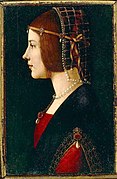
|
| |||
| La Bella Principessa | 1495–1496 (Kemp) | Bodycolour (pastel) on vellum | 33 cm × 22 cm 13.0 in × 8.7 in |
Private collection, Switzerland |
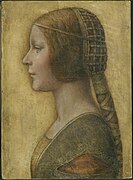
|
| |||
| Virgin of the Rocks Chéramy † | c. 1495–1497 (Pedretti) | Oil on wood panel, transferred to canvas | 154.5 cm × 122 cm 60.8 in × 48.0 in |
Private collection, Switzerland |
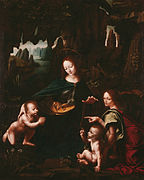
|
| |||
| Madonna and Child with St Joseph or Adoration of the Christ Child | between 1495 and 1500 | Tempera on panel | Diam. 87 cm (34 in) | Galleria Borghese, Rome[74] |
| Young Christ | c. 1496 | Terracotta | Private collection | |
| ||||
| Portrait of Luca Pacioli † | c. 1495–1500 | Tempera on panel | 99 cm × 120 cm 39 in × 47 in |
Museo di Capodimonte, Naples |

|
| |||
| Christ Carrying the Cross † | c. 1500 | Oil on poplar | Private collection, San Francisco | |

|
| |||
| Isleworth Mona Lisa † | Oil on canvas | 84.5 cm × 64.5 cm 33.3 in × 25.4 in |
Private collection, Switzerland | |

|
| |||
| Horse and Rider | Beeswax | Private collection, London | ||

|
| |||
| Lucan portrait of Leonardo da Vinci | c. 1505–1510 | Tempera grassa on poplar | 40 cm × 60 cm 16 in × 24 in |
Museo delle Antiche Genti di Lucania, Vaglio Basilicata |

|
| |||
| Portrait of a Man in Red Chalk | c. 1512 | Red chalk on paper | 33.3 cm × 21.6 cm 13.1 in × 8.5 in |
Biblioteca Reale, Turin |

|
||||
| Bacchus | Oil on walnut panel transferred to canvas | 177 cm × 115 cm 70 in × 45 in |
Louvre, Paris | |
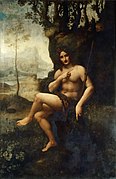
|
||||
| Mary Magdalene | 1515 | 58 cm × 45 cm 23 in × 18 in |
Private collection, Switzerland | |

|
| |||
See also
[edit]Notes
[edit]- ^ Far to the right, partially visible, is Salome with the Head of Saint John the Baptist by Bernardino Luini (a follower of Leonardo) and Bacchus, a disputed painting that is sometimes attributed to Leonardo.
- ^ On long-term loan from the Duke of Buccleuch collection[18]
- ^ Leonardo da Vinci and an anonymous 16th-century painter Syson (2011, p. 294); Workshop of Leonardo after a design by Leonardo Zöllner (2019, p. 239)
- ^ Salaì after a design by Leonardo Zöllner (2019, p. 238)
- ^ Identified via its similarity to Leonardo's presumed self-portrait[32]
- ^ "On the 10th of October, 1517, Monsignor and the rest of us went to see, in one of the outlying parts of Amboise, Messer Lunardo Vinci the Florentine, an old graybeard of more than 70 years, the most excellent painter of our time, who showed His Excellency three pictures [...] all most perfect, and from whom, since he was then subject to a certain paralysis of the right hand, one could not expect any more good work"[33]
- ^ Follower of Leonardo Syson (2011, p. 198, n. 9); "ascribed today to Leonardo" Marani (2003, p. 140)
- ^ Kemp (2004, p. 247)
- ^ Kemp 2004, p. 251; attributed there to "[Leonardo,] probably with his studio", but this work does not appear in a later edition (Kemp 2011).
- ^ Kemp 2004, p. 252; described there as "probably by Leonardo"
Sources for dating
[edit]- ^ The Annunciation
- Kemp (2019, p. 6): c. 1473–1474
- Marani (2003, p. 338): c. 1472–1475
- Syson (2011, p. 15): c. 1472–1476
- Zöllner (2019, p. 216): c. 1473–1475
- ^ Madonna of the Carnation
- Kemp (2019, p. 15): c. 1475
- Marani (2003, p. 338): between 1473 and 1478
- Syson (2011, p. 16): c. 1477–1478
- Zöllner (2019, p. 214): c. 1472–1478
- ^ The Baptism of Christ
- Covi (2005, p. 186): c. 1469–1472 by Verrocchio, then resumed by Leonardo perhaps mid-1470s
- Kemp (2019, p. 3): Leonardo c. 1474–1476
- Marani (2003, p. 338): Leonardo c. 1475–1478
- Syson (2011, p. 184): Verrocchio and Leonardo c. 1468–1477
- Zöllner (2019, p. 215): Verrocchio c. 1470–1472, Leonardo c. 1475
- ^ Ginevra de' Benci
- Kemp (2019, p. 17): c. 1478
- Marani (2003, p. 338): c. 1474/1475–1476
- Syson (2011, p. 48): c. 1474/1478
- Zöllner (2019, p. 218): c. 1478–1480
- ^ Benois Madonna
- Kemp (2019, p. 21): c. 1478–1480
- Marani (2003, p. 338): probably after March 1481
- Syson (2011, p. 18): c. 1481 onwards
- Zöllner (2019, p. 217): c. 1478–1480
- ^ The Adoration of the Magi
- Kemp (2019, p. 27): c. 1481–1482
- Marani (2003, p. 338): 1481
- Syson (2011, p. 56): c. 1480–1482
- Zöllner (2019, p. 222): 1481/1482
- ^ Saint Jerome in the Wilderness
- Kemp (2019, p. 31): c. 1481–1482
- Marani (2003, p. 338): probably c. 1480
- Syson (2011, p. 139): c. 1488–1490
- Zöllner (2019, p. 221): c. 1480–1482
- ^ Madonna Litta
- Kemp (2019, p. 39): c. 1495
- Marani (2003): not in checklist
- Syson (2011, p. 222): c. 1491–1495
- Zöllner (2019, p. 227): c. 1490
- ^ Virgin of the Rocks (Louvre version)
- Kemp (2019, p. 41): c. 1483–1493
- Marani (2003, p. 339): between 1483 and 1486
- Syson (2011, p. 164): 1483–c. 1485
- Zöllner (2019, p. 223): 1483–1484/1485
- ^ Portrait of a Musician
- Kemp (2019, p. 47): c. 1483–1486
- Marani (2003, p. 339): c. 1485
- Syson (2011, p. 95): c. 1486–1487
- Zöllner (2019, p. 225): c. 1485
- ^ Lady with an Ermine
- Kemp (2019, p. 49): c. 1491
- Marani (2003, p. 339): 1489–1490
- Syson (2011, p. 111): c. 1489–1490
- Zöllner (2019, p. 226): 1489/1490
- ^ La Belle Ferronnière
- Kemp (2019, p. 57): c. 1498
- Marani (2003, p. 339): c. 1490–1495 or 1495–1496
- Syson (2011, p. 123): c. 1493–1494
- Zöllner (2019, p. 228): c. 1496–1497
- ^ Virgin of the Rocks (London version)
- Kemp (2019, p. 153): c. 1495–1508
- Marani (2003, p. 340): 1491/1494, finished by 1508
- Syson (2011, p. 164): c. 1491/1492–1499 and 1506–1508
- Zöllner (2019, p. 229): c. 1495–1499 and 1506–1508
- ^ The Last Supper
- Kemp (2019, p. 67): c. 1495–1497
- Marani (2003, p. 339): between 1494 and 1498
- Syson (2011, p. 252): 1492–1497/1498
- Zöllner (2019, p. 230): c. 1495–1498
- ^ Sala delle Asse
- Kemp (2019, p. 63): c. 1498
- Marani (2003, p. 339): c. 1497–1498
- Syson (2011, p. 43): c. 1498
- Zöllner (2019, p. 233): c. 1498–1499
- ^ Virgin and Child with Saint Anne and Saint John the Baptist
- Chapman & Faietti (2010, p. 216, fig. 1): c. 1506–1508
- Kemp (2019, p. 157): c. 1507–1508
- Marani (2003, p. 339): c. 1499–1506
- Syson (2011, p. 89): c. 1499–1500
- Zöllner (2019, p. 234): 1499–1500 or c. 1508
- ^ Portrait of Isabella d'Este
- Kemp (2019, p. 101): 1500
- Marani (2003, p. 339): end of 1499 / early 1500
- Syson (2011, p. 44): c. 1499–1500
- Zöllner (2019, p. 236): December 1499 – March 1500
- ^ Madonna of the Yarnwinder (Buccleuch version)
- Kemp (2019, p. 103): c. 1501–1508
- Marani (2003, p. 339): no date given
- Syson (2011, p. 294): 1499 onwards
- Zöllner (2019, p. 239): c. 1501–1507
- ^ Salvator Mundi
- Kemp (2019, p. 149): c. 1504–1510
- Marani (2003): not in checklist; lost at the time of publication.
- Syson (2011, p. 300): c. 1499 onwards
- Zöllner (2019, p. 250): c. 1507 onwards
- ^ Madonna of the Yarnwinder (Lansdowne version)
- Kemp (2019, p. 103): c. 1501–1508
- Marani (2003, p. 339): no date given
- Syson (2011): no date given
- Zöllner (2019, p. 238): c. 1501–1507
- ^ Virgin and Child with Saint Anne
- Kemp (2019, p. 161): c. 1508–1516
- Marani (2003, p. 340): c. 1510–1513
- Syson (2011, p. 70): c. 1501 onwards
- Zöllner (2019, p. 244): c. 1503–1519
- ^ Mona Lisa
- Kemp (2019, p. 127): c. 1503–1515
- Marani (2003, p. 340): c. 1503–1504; 1513–1514
- Syson (2011, p. 48): c. 1502 onwards
- Zöllner (2019, p. 240): c. 1503–1506; 1510
- ^ La Scapigliata
- Kemp (2019): Not listed
- Marani (2003, p. 340): c. 1508
- Syson (2011, p. 198): no date given
- Zöllner (2019): not in checklist
- ^ Saint John the Baptist
- Kemp (2019, p. 189): c. 1507–1514
- Marani (2003, p. 340): c. 1508
- Syson (2011, p. 63): c. 1500 onwards
- Zöllner (2019, p. 248): c. 1508–1516
References
[edit]- ^ a b Marani 2003, pp. 338–340; Zöllner 2019, pp. 214–251.
- ^ a b c d e Ottino della Chiesa 1967.
- ^ Zöllner 2019, p. 215.
- ^ Zöllner 2019, p. 218–219.
- ^ Marani 2003, p. 338: "Attribution to Leonardo is unchallenged."
- ^ Zöllner 2019, p. 222.
- ^ Marani 2003, p. 338: "Attribution to Leonardo has never been seriously questioned."
- ^ "National Gallery in London accused of altering attribution of Hermitage's 'Leonardo' for 2011 blockbuster show". www.theartnewspaper.com. 30 March 2018. Retrieved 13 August 2018.
- ^ Marani 2003, p. 339: "Attribution to Leonardo is unchallenged."
- ^ Zöllner 2019, p. 225.
- ^ Zöllner 2019, p. 226.
- ^ Zöllner 2019, p. 228.
- ^ Marani 2003, pp. 175–178.
- ^ Marani 2003, p. 339: "Attribution to Leonardo has never been contested."
- ^ Marani 2003, p. 339: "Unanimously recognized as the only surviving fragments by Leonardo for this room."
- ^ Marani 2003, p. 339: "Attribution to Leonardo is unanimous."
- ^ Ames-Lewis (2012, p. 227)
- ^ Zöllner 2019, p. 239.
- ^ Kemp 2011, 253
- ^ Syson 2011, 294
- ^ Syson 2011, 302
- ^ Andrews, Travis M. (15 November 2017). "Long-lost da Vinci painting fetches $450 million, a world record". The Washington Post. Retrieved 16 November 2017.
- ^ Holland, Oscar (16 November 2017). "Rare Da Vinci painting smashes world records with $450 million sale". CNN. Retrieved 16 November 2017.
- ^ "Who Really Painted 'Salvator Mundi'? An Oxford Art Historian Says It Was Leonardo's Assistant | artnet News". artnet News. 7 August 2018. Retrieved 13 August 2018.
- ^ Cascoin, Sarah (27 August 2021). "7 Unbelievable and Contentious Takeaways From a New Documentary About 'Salvator Mundi,' the $450 Million 'Lost Leonardo'". Artnet. Retrieved 20 April 2022.
- ^ Bailey, Martin (11 November 2021). "Prado museum downgrades Leonardo's $450m Salvator Mundi in exhibition catalogue". The Art Newspaper. Retrieved 12 November 2022.
- ^ "Sold for $450m to Saudi prince, 'Salvator Mundi' deemed not painted by Leonardo". Times of Israel. 14 November 2021. Retrieved 13 November 2022.
- ^ Zelazko, Alicja (April 2022). "Why Is the Salvator Mundi Called the World's Most Controversial Painting?". Encyclopædia Britannica. Retrieved 13 November 2022.
- ^ Marani 2003, p. 340: "Although the painting's condition is poor, it should be considered a very damaged original by Leonardo."
- ^ Marani 2003, p. 340: "Unanimously attributed to Leonardo, although there is little agreement on its date."
- ^ Strickland, Ashley (4 May 2019). "What caused Leonardo da Vinci's hand impairment?". CNN. Retrieved 4 May 2019.
- ^ a b McMahon, Barbara (1 May 2005). "Da Vinci 'paralysis left Mona Lisa unfinished'". The Guardian. Retrieved 2 May 2019.
- ^ Wallace, Robert (1972) [1966]. The World of Leonardo: 1452–1519. New York: Time-Life Books. p. 163.
- ^ Lorenzi, Rossella (10 May 2016). "Did a Stroke Kill Leonardo da Vinci?". Seeker. Retrieved 10 June 2021.
- ^ Saplakoglu, Yasemin (4 May 2019). "A Portrait of Leonardo da Vinci May Reveal Why He Never Finished the Mona Lisa". Live Science. Retrieved 5 May 2019.
- ^ Bodkin, Henry (4 May 2019). "Leonardo da Vinci never finished the Mona Lisa because he injured his arm while fainting, experts say". The Telegraph. Retrieved 6 May 2019.
- ^ Zöllner 2019, p. 248.
- ^ Kemp 2007, pp. xxviii–xxix.
- ^ Clayton 2006, p. 16.
- ^ "The Forster Codices: Leonardo da Vinci's Notebooks at the V&A". Victoria and Albert Museum. Retrieved 4 November 2012.
- ^ "Paris Manuscript B". Universal Leonardo. University of the Arts, London. Retrieved 3 November 2012.
- ^ "Paris Manuscript C". Universal Leonardo. University of the Arts, London. Retrieved 3 November 2012.
- ^ "Paris Manuscript A". Universal Leonardo. University of the Arts, London. Retrieved 3 November 2012.
- ^ "Paris Manuscript H". Universal Leonardo. University of the Arts, London. Retrieved 3 November 2012.
- ^ "Paris Manuscript M". Universal Leonardo. University of the Arts, London. Retrieved 3 November 2012.
- ^ "Paris Manuscript L". Universal Leonardo. University of the Arts, London. Retrieved 3 November 2012.
- ^ "Paris Manuscript K". Universal Leonardo. University of the Arts, London. Retrieved 3 November 2012.
- ^ "Paris Manuscript I". Universal Leonardo. University of the Arts, London. Retrieved 3 November 2012.
- ^ "Paris Manuscript D". Universal Leonardo. University of the Arts, London. Retrieved 3 November 2012.
- ^ "Paris Manuscript F". Universal Leonardo. University of the Arts, London. Retrieved 3 November 2012.
- ^ "Paris Manuscript E". Universal Leonardo. University of the Arts, London. Retrieved 3 November 2012.
- ^ "Paris Manuscript G". Universal Leonardo. University of the Arts, London. Retrieved 3 November 2012.
- ^ "Codex Madrid I". Universal Leonardo. University of the Arts, London. Retrieved 3 November 2012.
- ^ "Codex Madrid II". Universal Leonardo. University of the Arts, London. Retrieved 3 November 2012.
- ^ Bambach 2003, p. 723.
- ^ "Codex Urbinas and lost Libro A". Universal Leonardo. University of the Arts, London. Retrieved 12 April 2012.
- ^ a b c d Marani 2003, p. 431.
- ^ a b c Marani 2003, p. 431
- ^ Rubin & Wright 1999, pp. 84 and 118, n. 25
- ^ Farmer, Brit Mccandless (26 May 2019). "From the archives: Looking for the lost Leonardo". CBS News. Retrieved 8 October 2019.
- ^ Nicholl, Charles. Leonardo Da Vinci : Flights of the Mind. New York, N.Y., U.S.A. :Viking Penguin, 2004., page 602
- ^ Shearman 1992, p. 33.
- ^ Delieuvin 2012, cat. 80
- ^ Delieuvin 2012, cat. 81
- ^ "St John the Baptist". Art UK. Retrieved 15 July 2013.
- ^ a b Marani 2003.
- ^ Arasse, Daniel (1997). Leonardo da Vinci. Konecky & Konecky. ISBN 978-1-56852-198-5.
- ^ Kemp 2011; no date in Marani 2003, but accepted by him
- ^ Kemp 2004, p. 251.
- ^ Portrait of a Lady. Biblioteca Ambrosiana. Retrieved 20 December 2020.
- ^ Adams, James (13 October 2005). "Montreal art expert identifies da Vinci drawing". The Globe and Mail. Retrieved 14 October 2009.
- ^ "The Mark of a Masterpiece" by David Grann, The New Yorker, vol. LXXXVI, no. 20, 12 & 19 July 2010, ISSN 0028-792X
- ^ Pedretti, Carlo; Taglialagamba, Sara (2017). Leonardo da Vinci: the "Virgin of the rocks" in the Cheramy version: its history & critical fortune. Poggio a Caiano: CB edizioni. ISBN 9788897644538.
- ^ Moreno, Paolo; Stefani, Chiara. The Borghese Gallery. Milan: Touring Club Italiano. p. 230.
- ^ a b MacKinnon, Nick (1993). "The Portrait of Fra Luca Pacioli". The Mathematical Gazette. 77 (479): 140–43, 146–49, 154, 165, 183, 184, 186–87, 197–205, 214. doi:10.2307/3619717. JSTOR 3619717. S2CID 195006163.
- ^ "ritratto Pacioli". www.ritrattopacioli.it (in Italian).
- ^ Livio, Mario (2003) [2002]. The Golden Ratio: The Story of Phi, the World's Most Astonishing Number (First trade paperback ed.). New York City: Broadway Books. pp. 130–131, 138. ISBN 0-7679-0816-3.
- ^ Bo, Gianfranco. "Il sorriso di Pacioli". utenti.quipo.it (in Italian).
- ^ a b c Stephane Fitch DaVinci's Fingerprints, 12.22.03 accessed 7 July 2009. Martin Kemp, the expert on Leonardo's fingerprints, had not examined the painting when the article was written.
- ^ A similar image, without the tormentors, is in the Hermitage Museum, St Petersburg. [1][permanent dead link]
- ^ "'Early Mona Lisa' painting claim disputed". BBC News. 27 September 2012. Retrieved 26 January 2013.
- ^ Pedretti, Carlo (10 July 1985). "Wax model of Horse and Rider". Letter to Mr. Paul J. Wagner. Archived from the original on 8 October 2014.
- ^ Petty, J.W. Provenance – Expert's Analysis & Scientific Studies. CDI Publishing, 2021, p. 4.
- ^ Solari, Ernesto (2016). Leonardo da Vinci : Horse and rider : il "monumento" a Charles d'Amboise. Leonardo, da Vinci, 1452–1519,, Palazzo delle Stelline (Prima edizione ed.). Paderno Dugnano (Mi). ISBN 9788897206330. OCLC 962823523.
{{cite book}}: CS1 maint: location missing publisher (link) - ^ Pedretti, Carlo, ed. (1987). Leonardo Da Vinci: Drawings of Horses and Other Animals from the Royal Library at Windsor Castle. London: Harcourt Brace. p. 185. ISBN 0384-45284-1.
Fig 111 and 112 Unpublished fragmentary wax model of an equestrian portrait of Charles d'Amboise attributed to Leonardo, said to have come from the Melzi estate at Vaprio d'Adda. London, Private collection (formally Sangiorgi collection in Rome).
- ^ "'Horse and Rider' Discovered Leonardo Da Vinci Sculpture". Huffington Post. 14 August 2012. Retrieved 16 January 2014.
- ^ Solari, Ernesto (2016). Leonardo da Vinci Horse and Rider Il "Monumento" a Charles d'Amboise. Milan: Colibri Edizioni. p. 28. ISBN 978-88-97206-33-0.
Carlo Pedretti: In my opinion, this wax model is by Leonardo himself, and to my knowledge it has not been seen by other scholars.
- ^ "Leonardo da Vinci's 'Horse and Rider'". BBC News. 28 August 2012. Retrieved 16 January 2014.
- ^ Petty, J.W. Provenance – Expert's Analysis & Scientific Studies. CDI Publishing, 2021, p. 4.
- ^ "Another Da Vinci of Disputed Origin Heads to Auction in New York". Bloomberg.com. 2 October 2019. Retrieved 18 November 2024.
- ^ Zerner, Henri (25 September 1997). "The Vision of Leonardo". The New York Review of Books. 44 (14): 67.
no existing sculpture can be attributed to him with any certainty. [... the Bust of Christ as a Youth] was unfortunately placed in the exhibition next to a bizarre object, a wax statuette of a rider on a bucking horse never before seen in public. In the explanatory label, the statuette was said to have belonged to Francesco Melzi, a student and companion of Leonardo, a provenance unfortunately based on hearsay. [...] I fail to see the point of presenting to the uninformed visitor highly debatable hypotheses as if they were confirmed.
- ^ Holmstrom, David (24 March 1997). "Putting Leonardo's Inventions to the test: Boston's Museum of Science looks at the breathtaking scope of Leonardo da Vinci's work, though the authenticity of some objects is in question". The Christian Science Monitor. ProQuest 405615445.
CONTROVERSIAL WORK: Whether Leonardo made this small wax figure is a source of contention among experts. Although the piece is unsigned, it is attributed to him in the exhibit.
(subscription required) - ^ Yemma, John (23 February 1997). "Leonardo on tour: the good, the bad ... and the phony? Art historians question attribution of some works headed for Boston show". The Boston Globe. p. A.1.
at least one of the two sculptures on display in the art gallery at Science Park beginning March 3 have caused grave doubts among some art historians. [...] The labels on the paintings, Ackerman warned museum officials, were simply too generous, linking dubious and contested works from private collections too closely with Leonardo and other Italian masters. [...] after weeks of struggling over wording, museum officials altered some of the labels to introduce more skepticism [... The Wax Horse] is "attributed to Leonardo." Not so fast, said Jack Wasserman, an art historian at Temple University in Philadelphia. "There is no single work of sculpture which Leonardo worked on that survived to today," Wasserman said. "Yes, it could be 'attributed to' Leonardo, but you need to have a compelling reason for doing so. Since nothing survived, there is no way to judge a piece of sculpture like this."
(subscription required) - ^ Panza, Pierluigi (19 October 2016). "La scultura equestre di Leonardo Esposizione tra genio e mistero". Corriere della Sera (in Italian). Retrieved 1 March 2017.
- ^ Gatti, Chiara (19 October 2016). "Arriva l'uomo a cavallo di Leonardo Da Vinci che divide i critici". la Repubblica (in Italian). Retrieved 22 February 2017.
Presentata come una rivelazione esclusiva, è contestata da molti esperti. [...] Vittorio Sgarbi non nasconde i suoi dubbi sull'attribuzione al maestro toscano [...] Pietro Marani: Non ci sono evidenze, né si possono fare confronti poiché non esistono dati d'appoggio, esemplari sicuri.
- ^ Sturman, Shelley; May, Katherine; Luchs, Alison (2017). "The Budapest Horse: Beyond the Leonardo da Vinci Question". In Helmstutler Di Dio, Kelley (ed.). Making and Moving Sculpture in Early Modern Italy. Routledge. p. 27. ISBN 978-1-351-55951-5.
- ^ Self-portrait of Leonardo, Surrentum Online, accessed 6 November 2010
- ^ Scaramella, A. D. "Artwork Analysis self Portrait in Red Chalk by Leonardo Da Vinci". Finearts.com. Helium Inc. Archived from the original on 29 November 2014. Retrieved 16 November 2014.
- ^ "Emergency Treatment for Leonardo da Vinci's Self-Portrait". news.universityproducts.com. Archival Products. Retrieved 16 November 2014.
- ^ Kemp 2011.
- ^ Kemp 2004, p. 2011.
- ^ "A lost Leonardo? Top art historian says maybe". Universal Leonardo. Retrieved 27 September 2007.
- ^ Bertelli, Carlo (19 November 2005). "Due allievi non fanno un Leonardo" (in Italian). Il Corriere della Sera. Archived from the original on 26 September 2007. Retrieved 27 September 2007.
Sources
[edit]- Ames-Lewis, Francis (2012). Isabella and Leonardo: The Artistic Relationship between Isabella d'Este and Leonardo da Vinci, 1500–1506. New Haven, Connecticut: Yale University Press. ISBN 978-0-300-12124-7.
- Bambach, Carmen C., ed. (2003). Leonardo da Vinci: Master Draftsman. New Haven, Connecticut: Yale University Press. ISBN 978-1588390332.
- Chapman, Hugo; Faietti, Marzia (2010). Fra Angelico to Leonardo: Italian Renaissance Drawings. London, England: British Museum Press. ISBN 978-0-7141-2667-8.
- Ottino della Chiesa, Angela (1967). The Complete Paintings of Leonardo da Vinci. Penguin Classics of World Art. London, UK: Penguin Books. ISBN 978-0-14-008649-2.
- Clayton, Martin (2006). Ten Drawings by Leonardo da Vinci: An Exhibition to Celebrate the Eightieth Birthday of Her Majesty The Queen. Royal Collection Publications. ISBN 9-781902-163017.
- Covi, Dario A. (2005). Andrea del Verrocchio: Life and Work. Arte e archeologia: Studi e documenti. Florence, Italy: Leo S. Olschki Editore. ISBN 978-8822254207.
- Delieuvin, Vincent, ed. (2012). Saint Anne: Leonardo da Vinci's Ultimate Masterpiece. Milan, Italy: Officina Libraria. ISBN 978-8897737025.
- Kemp, Martin (2004). Leonardo. Oxford, England: Oxford University Press. ISBN 9-780192-806444.
- ——— (2007). Leonardo da Vinci: The Marvellous Works of Nature and Man. Oxford, England: Oxford University Press. ISBN 978-0-19-920778-7.
- ——— (2011). Leonardo: Revised edition. Oxford, England: Oxford University Press. ISBN 978-0199583355.
- ——— (2019). Leonardo da Vinci: The 100 Milestones. New York City, New York: Sterling. ISBN 978-1454930426.
- Marani, Pietro C. (2003). Leonardo da Vinci: The Complete Paintings. New York, New York: Harry N. Abrams, Inc. ISBN 978-0810991590.
- Pedretti, Carlo (1987). Leonardo Da Vinci: Drawings of Horses and Other Animals from the Royal Library at Windsor Castle. New York, New York: Johnson Reprint Corp. ISBN 978-0384452824.
- ——— , ed. (1988). Achademia Leonardi Vinci: Journal of Leonardo Studies & Bibliography of Vinciana Vol. I–X. Villa La Loggia, Florence: Guinti. ISBN 978-0815001034.
- ——— (2006). Leonardo: Art and Science. Surrey, England: Taj Books International. ISBN 978-1844060368.
- Pedretti, Carlo; Taglialagamba, Sara (2017). Leonardo da Vinci: the "Virgin of the rocks" in the Cheramy version: its history & critical fortune. Poggio a Caiano, Italy: CB edizioni. ISBN 978-8897644538.
- Rubin, Patricia Lee; Wright, Alison (1999). Renaissance Florence: The Art of the 1470s. London, England: National Gallery Publications. ISBN 978-1857092660.
- Shearman, John (1992). Only Connect: Art and the Spectator in the Italian Renaissance. Oxford, England: Oxford University Press. ISBN 978-0691655413.
- Solari, Ernesto (2016). Leonardo da Vinci Horse and Rider Il "Monumento" a Charles d'Amboise. Milan: Colibri Edizioni. ISBN 978-88-97206-33-0.
- Syson, Luke; Keith, Larry; Galansino, Arturo; Mazzotta, Antonio; Nethersole, Scott; Rumberg, Per (2011). Leonardo da Vinci: Painter at the Court of Milan (1st ed.). London, England: National Gallery. ISBN 978-1857094916.
- Zöllner, Frank (2019). Leonardo da Vinci: The Complete Paintings and Drawings (Anniversary ed.). Cologne, Germany: Taschen.
External links
[edit]- Leonardo's works on Universal Leonardo
- Leonardo's works on Web Gallery of Art
- The Codex Arundel on the British Library's Digitised Manuscripts Website
- Works by Leonardo on cavallinitoveronese.co.uk
 KSF
KSF


